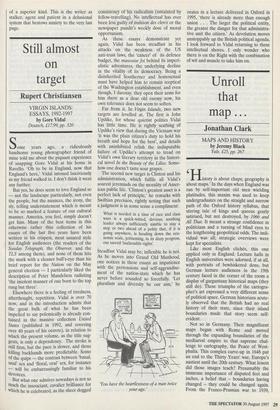Unroll that map ...
Jonathan Clark
MAPS AND HISTORY by Jeremy Black Yale, £25, pp. 267 History is about chaps; geography is about maps.' In the days when England was run by self-important old men wielding platitudes, this maxim was used to keep undergraduates on the straight and narrow path of the Oxford history syllabus, that stirring tale of kings and queens gently satirised, but not destroyed, by 1066 and All That. It meant a strange confidence in politicians and a turning of blind eyes to the lengthening geopolitical odds. The indi- vidual was all; strategic overviews were kept for specialists.
Like most English cliches, this one applied only in England. Lecture halls in English universities were adorned, if at all, with portraits of bewhiskered dons, but German lecture audiences in the 19th century faced in the corner of the room a display of gargantuan historical maps (they still do). These triumphs of the cartogra- pher's art expressed a very different sense of political space. German historians acute- ly observed that the British had no real history of their state, since their island boundaries made that story seem self- evident.
Not so in Germany. Their magnificent maps began with Rome and moved through the expanding boundaries of the mediaeval empire to that supreme chal- lenge to cartography, the Peace of West- phalia. This complex carve-up in 1648 put an end to the Thirty Years' war, Europe's nastiest until the 20th century. What lesson did those images teach? Presumably the immense importance of disputed feet and inches, a belief that – boundaries having changed – they could be changed again. From the Franco-Prussian war to 1939, Fench and German cartographers waged campaigns parallel to those of their politi- cal masters. Meanwhile, the English paint- ed large areas pink, using brushes so broad that they obscured the cracks in the plaster. Maps of the British Empire paid little attention to subtle divisions. The character- istic English descriptions of the world were the Admiralty chart and the map of the heavens, in both of which we were world leaders. Yet for most historians all this has been — almost literally — off the map.
While others struggle to satisfy the research productivity exercise, two histori- ans have fundamentally altered our sense of the English past by astonishing solo pro- ductivity: Roy Porter on the social history of medicine, Jeremy Black on geopolitics, diplomacy and war. For zeal, enthusiasm and verve it would be hard to match either. And their impact is similar: both over- whelm us with a mass of new material, unfamiliar and meant to unsettle. Even the general course of the events that they record cannot be taken for granted. In our age of uncertainty, the most prolific histori- ans are those who have lost their inhibi- tions and admit that the more things change, the more easy it is to change them still further.
Black's book shows just what a historian should reveal: far from being neutral records of the extension of measurement and rationality, maps have always been profoundly purposeful things. An easy point to make, desperately hard to prove. Remarkably, this is the first survey in English of how people in Europe and America depicted the space in which they lived from Abraham Ortelius's historical atlas of 1570 to the latest moment. If every picture tells a story, every map tells of a programme, a boast, an attempt to project priorities onto the world. National founda- tion myths, the claims of world religions, the expansionary ambitions of nation states, the cosmopolitan ideologies of the environmentalists, all these can be, and often are, expressed more insidiously and tendentiously in maps than in prose.
Yet although cartography is demonstra- bly influenced by the historical agenda, Black shows how 'the historical agenda is far from constant'. Adopting this insight, what new message can we expect to see in our maps in coming decades? First, of course, that the United Kingdom is a recently invented nation; that the British were always riotously plural; that the pic- ture on the ground is so complex that only regional devolution and Scots indepen- dence can possibly count as an adequate response. Next, of course, that England herself has always been part of, indeed merged in, continental European politics. They will say that the market demands this; the public may suspect that its perception of its public space is being deliberately moulded. Which is right? For a clue to the next round of geopolitical conflict in the British Isles, read this book.



















































 Previous page
Previous page